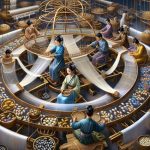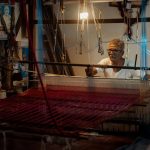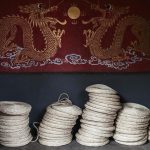Imagine a world where fabrics didn't just cover your body but defined entire civilizations. You'll find that fabrics have been far more than mere textiles; they've served as cultural cornerstones, marking societal status, wealth, and identity. Whether it's the fine linens of ancient Egypt or the vibrant textiles of African traditions, each fabric tells a story. The Silk Road, for instance, wasn't just a trade route but a tapestry of shared knowledge and artistry. Curious about how these threads of history interweave across continents and eras? There's more to uncover about this fascinating cultural phenomenon.
Table of Contents
Key Takeaways
- Ancient Egyptian linens symbolized purity and sophistication, reflecting cultural values and social status.
- Chinese silks represented wealth and cultural elegance, playing a crucial role in societal hierarchies.
- Medieval European tapestries served as symbols of power and prestige, often depicting religious narratives.
- The Silk Road facilitated cultural exchange, introducing new textile designs and weaving methods that enhanced global textile quality.
- Colonial American homespun fabrics symbolized resistance against British imports, fostering a sense of communal identity and autonomy.
Ancient Textile Traditions
Ancient textile traditions reveal much about the daily lives and cultural values of early civilizations. When you look at Egyptian linens, you'll see they weren't just prized for their practicality but also for their symbolic significance. Egyptians considered linen a symbol of purity and used it extensively in both daily life and burial practices. The fine craftsmanship of these linens reflected the sophistication of Egyptian society.
In China, silk production was an art form that symbolized wealth and status. Chinese silks weren't merely luxurious; they were a reflection of advanced technology and the high value placed on beauty and elegance. Mastering the art of silk-making was a closely guarded secret, underscoring its cultural significance.
Greek tunics, or chitons, were more than simple garments. They revealed much about one's social status and role in society. Similarly, Roman togas were iconic symbols of Roman citizenship and political status. Wearing a toga wasn't just about fashion; it was a declaration of one's place in the complex hierarchy of Roman society.
Silk Road Influences
The Silk Road wasn't just a trade route; it wove together the cultural and textile traditions of distant civilizations. As you explore its history, you'll discover how it facilitated unparalleled cultural exchange and luxury trade. The treasures that traveled this network included silk, spices, and precious stones, but more importantly, it carried ideas, artistic techniques, and unique textile practices that shaped entire cultures.
Imagine traders from China introducing their exquisite silk to Persian markets, sparking an artistic fusion that resulted in new fabric designs and weaving methods. These weren't just commodities; they were symbols of status and sophistication, coveted by elites across continents. The global connections fostered by the Silk Road created a rich tapestry of shared knowledge and craftsmanship.
Understanding the Silk Road's influence means appreciating how it acted as a conduit for innovation. Persian, Indian, and Chinese artisans learned from each other, leading to advancements in dyeing, weaving, and embroidery techniques. This fusion didn't just enhance the quality and variety of textiles; it also strengthened the cultural bonds between East and West, leaving a lasting legacy that continues to inspire modern textile artisans.
Medieval European Tapestries
Often celebrated for their intricate beauty and storytelling, Medieval European tapestries offer a vivid glimpse into the lives and legends of the past. Imagine walking into a grand hall adorned with these masterpieces, each one a tribute to Gothic craftsmanship and royal commissions. These tapestries weren't merely decorative; they served as visual chronicles of history, religion, and society.
You'd find that Biblical narratives dominated many tapestries, capturing scenes with vibrant colors and painstaking detail. Each thread was a brushstroke in a larger, woven picture that conveyed moral lessons and divine stories. The craftsmanship involved was unparalleled, with artisans spending years on a single piece.
Consider these facets to grasp their deeper significance:
- Gothic Craftsmanship: Exemplified the pinnacle of artistic skill during the era.
- Royal Commissions: Highlighted the significance of tapestries as symbols of power and prestige.
- Biblical Narratives: Provided a visual catechism for a largely illiterate population.
- Vibrant Colors: Enhanced the emotional and spiritual impact of each scene.
Colonial American Fabrics
You're about to explore how textile trade dynamics shaped Colonial America, influencing everyday life and economic structures.
The Homespun Movement played a pivotal role in fostering self-reliance and political expression through fabric creation.
You'll also see how different fabrics carried symbolic meanings that reflected societal values and resistance.
Textile Trade Dynamics
In Colonial America, textile trade shaped both the economy and daily life, forging connections between the colonies and the wider world. Textiles weren't just commodities; they were pivotal in the global market, facilitating a rich cultural exchange. Imported fabrics brought European styles and techniques, while local production began to evolve, reflecting the unique needs and resources of the colonies.
Consider the following to grasp the nuances of this dynamic:
- Economic Backbone: Textiles were a major driver of the colonial economy, often used as currency and a measure of wealth.
- Cultural Bridge: The exchange of fabrics and designs between Europe and the colonies fostered a fusion of cultural aesthetics, enriching both spheres.
- Technological Transfer: The import of European weaving techniques and machinery spurred local innovation, leading to a distinctive colonial textile industry.
- Social Stratification: Access to various textiles often indicated social status, with finer imports being a luxury for the affluent.
Homespun Movement Influence
The Homespun Movement in Colonial America championed self-reliance by encouraging colonists to produce their own fabric, reducing dependence on British imports. This movement wasn't just a reaction to economic policies but a form of grassroots activism that resonated deeply with the principles of DIY fashion and sustainable living.
Colonists took to their spinning wheels and looms, weaving their own cloth from locally sourced materials. This artisanal craftsmanship wasn't merely a necessity; it was a statement of defiance and independence.
By embracing the Homespun Movement, you're tapping into a rich tradition of self-sufficiency and sustainability. Each garment crafted was a tribute to the colonists' resolve and ingenuity. The fabrics produced were more than just materials; they symbolized the colonists' fight for autonomy and their resistance to colonial control.
Understanding this movement helps you appreciate the broader cultural shifts that were taking place. It was about more than just fabric; it was a shift towards a sustainable and self-reliant community.
Fabric Symbolism Roles
As you explore the fabric symbolism in Colonial America, you'll find that textiles carried profound meanings that went beyond their practical uses. Fabrics weren't just materials for clothing; they were woven into the very fabric of social and political life. Each textile held its own symbolic meanings and cultural significance, reflecting the values and struggles of the time.
In Colonial America, these fabrics conveyed deeper messages:
- Liberty and Resistance: Homespun fabrics became symbols of resistance against British imports, embodying the spirit of independence and self-reliance.
- Social Status: The quality and type of fabric worn indicated one's social standing. Fine silks and brocades were reserved for the elite, while coarse wool and linen were common among the working class.
- Economic Power: The control and production of textiles were essential for economic autonomy. Colonists' shift to local fabric production undermined British economic dominance.
- Community and Identity: Group efforts in spinning and weaving fostered a sense of communal identity and shared purpose, reinforcing cultural ties and collective resilience.
African Textile Artistry
African textile artistry showcases a vibrant tapestry of cultural heritage and innovation. When you explore this rich tradition, you'll find that traditional weaving techniques and vibrant colors are at the heart of African textiles. Each region boasts its own unique methods and patterns, often passed down through generations.
The intricate designs and vivid hues aren't just visually stunning; they're a tribute to the weavers' skills and the community's aesthetic values.
The cultural significance of these textiles goes beyond mere decoration. They serve as a medium for storytelling through textiles, encapsulating histories, beliefs, and social messages. For instance, Kente cloth from Ghana uses specific patterns and colors to convey proverbs and historical events.
The meanings behind these designs offer a deep connection to the past and a way to communicate important cultural narratives.
In Nigeria, the Yoruba people's Aso Oke fabric similarly highlights traditional weaving techniques and vibrant colors. This fabric is often used in ceremonial attire, underscoring its role in cultural rites and social identity.
Modern Fabric Innovations
Innovations in modern fabric technology are revolutionizing how we think about textiles and their applications. You're witnessing a transformation where sustainable textiles and smart fabrics are leading the charge.
Sustainable textiles are reducing environmental impact by using organic materials, recycled fibers, and eco-friendly dyeing processes. Meanwhile, smart fabrics are integrating technology into the very weave of the material, offering new functionalities and even enhancing personal well-being.
Consider these groundbreaking advancements:
- Biodegradable fabrics: These materials break down naturally, minimizing waste and promoting a circular economy.
- Conductive textiles: Embedded with electronic components, these fabrics can monitor health metrics or control devices.
- Self-healing materials: Designed to repair minor damages on their own, extending the lifespan of the fabric.
- Thermo-regulating textiles: These fabrics adjust to your body temperature, providing ideal comfort in varying conditions.
Frequently Asked Questions
How Did Fabrics Influence Social Status in Ancient Civilizations?
You'll find that in ancient civilizations, fabrics greatly impacted social hierarchy. Economic power was often displayed through luxurious textiles. The textile trade shaped fashion trends, reinforcing the status and wealth of the elite class.
What Are the Environmental Impacts of Traditional Fabric Production Techniques?
Imagine the earth weeping with every weave. You'll find that traditional fabric production techniques leave a hefty carbon footprint and guzzle water, contributing to environmental degradation. Mastering sustainable methods is vital for a greener future.
How Have Global Trade Routes Historically Affected Fabric Availability?
You can see how global trade routes like the Silk Road increased fabric availability, bringing luxurious textiles to new markets. European influence expanded these routes, making exotic fabrics accessible and revolutionizing fashion and industry.
What Role Did Fabrics Play in Religious or Ceremonial Practices?
Imagine fabrics as the "Instagram filters" of ancient ceremonies. You'd find fabric symbolism deeply embedded in ceremonial attire, representing status, purity, or divinity. These textiles transformed ordinary moments into profound spiritual experiences.
How Are Fabrics Preserved and Restored in Museums Today?
In museums today, you'll find textile conservation experts meticulously applying restoration techniques to preserve fabrics. They stabilize the material, repair damage, and carefully control environmental conditions to sustain these precious textiles endure for future generations.
- The Use of Nonwovens in Construction and Civil Engineering - July 11, 2025
- The Use of Nonwovens in Construction and Civil Engineering - July 11, 2025
- The Use of Nonwovens in Construction and Civil Engineering - July 11, 2025







